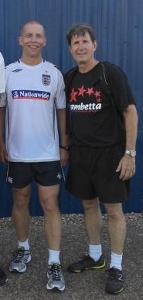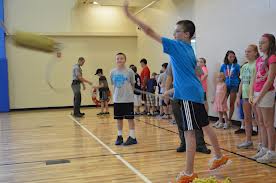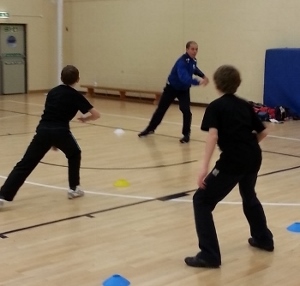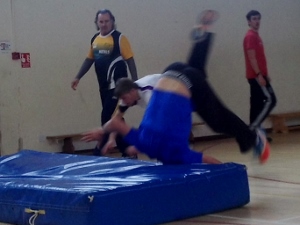How to create an outstanding physical education programme
“If you screw up your kids, nothing else matters”
 Greg Thompson, GAIN 2013.
Greg Thompson, GAIN 2013.
Physical education used to be about function: getting fit to help with a full day’s work and then helping with the harvest. Now its about sport.
“A high-quality physical education curriculum inspires all pupils to succeed and excel in competitive sport and other physically demanding activities“. U.K. national p.e. curriculum guidelines.
I have written previously about the role physical education has in the structure and well being of our society . Sadly this is still missing.
Last year at GAIN I was privileged to listen to Greg Thompson talk about his work at Farmington Schools. He also taught an example p.e lesson. Both were outstanding. Enthusiasm and passion linked with a detailed knowledge of the correct physical developmental stages for children.
Here are some of the key points I took. I am trying to implement these within the courses I run, and also the work I am doing with my children’s schools in Willand.
“Quality of design leads to user delight”
James coaching youngsters
Seth Godin. The better the design of the p.e programme, the better the children will enjoy it.
Greg (a keen sailor) remarked that his boat has got a keel. “Unfortunately, p.e doesn’t. P.e drifts in the direction of the latest prevailing wind. Quality content is being blown off course by marketing.”
Marketing can include “academic studies” that use school pupils as test subjects (Personal note: often the actual intervention is done by poorly trained undergraduates, rather than qualified teachers).
Moderately vigorous physical activity (MVPA) is one such wind, where heart rate is the the only measure of work done. The “dance, dance, revolution” is another. “Fun is #1” is often the barometer of success rather than what is being achieved or giving the children physical skills for life (enough meteorological analogies now).
The one size fits all approach is great for MVPA or sports based p.e. But, the physical education specialist is an endangered species, we are on the precipice of them being replaced by $7 hour “fun leaders“.
“The Moderately Vigorous Physical Activity movement has lead to a generation of college professors and young teaching offspring who have lost contact with quality movement. By pushing fun as a first priority, children’s “normal” has changed. They expect physical education to be game playing. Hard work is a rarity. In our high schools, teachers fear making students in their classes perspire will lead to less students signing up for PE electives (= less teaching jobs).” Thompson.
The erosion of quality content leads to greatly reduced contact time and devalues the work of teachers. No one has said “calculus is hard, let’s not bother” so why do we do it with p.e?
Questions you might want to ask of your child’s school or of your own teaching:
- What happens to develop physical competence?
- What happens to develop skilful movement?
- What happens to develop perseverance?
(I am delighted to see Willand school encouraging perseverance).
Create an intoxicating physical education environment
The Unicef definition of quality of teaching/education states that a good physical education teacher should be well grounded in:
- Motor Learning
- Athletic Development
- Social & emotional development
- Inter-personal skills
If you add “observational skill” then you have someone who can perform “skilled assessment“. Does your child’s p.e teacher have these skills?
What about following an advanced pattern that is based on observing elite performers? An example being copying throwing patterns of baseball pitchers for primary school kids. This is an “error model” (see Greg’s comment below).
Instead, we should ask “Is there a known pattern of steps on the way to advanced?” We can then set task constraints to help the child get the right outcomes, remembering that the child has a role in this process.

Physical education requires movement
For example: throwing. A West Indian cricket fielder may run 2 steps from the boundary and sling the ball to the wicket keeper, planting the left leg and shifting weight forward, rotating the trunk first, then the arm following through.
The key point is the lag time between trunk rotation and arm movement, so that is what the p.e. teacher should be looking at first, rather than the foot planting.
There is no point looking at lag in the arm segments if the pupil stands face on to the target and throws the ball underarm. Instead, the teacher might create a task constraint where the pupil has to straddle a line that is parallel to the wall, then throw forcefully from lines that are progressively farther from the wall.
They can then progress to standing side on to the target, then to having a slightly wider foot stance.
“The idea of creating a task that elicits a positive change without having to engage in a lot of verbal instruction comes out of Esther Thelen’s research on dynamic systems.
The goal of the teacher using this approach is to pick a task that let’s the student “self organise” to the next level. So in the throwing example, a child who is not trunk rotating, begins to trunk rotate when we have them straddle the line and throw hard.
We don’t talk about trunk rotation with 5-year-olds, we just show them how to put one foot on each side of the line and let them back up to the next colour line when they can hit the wall from that one. The task squirts trunk rotation out.
This is a “dynamic systems approach to development” (Esther Thelen).
It applies to running, skipping, sliding and jumping as well. Is your child being taught these skills?
Kids learn what they see
 So much for the theory, how does this translate into a living, breathing entity?
So much for the theory, how does this translate into a living, breathing entity?
Greg is a great believer in using a playful approach and getting the kids to self organise. However, before this happens they need to have a “mind’s eye picture” of what it is they are supposed to do.
- Create mindfulness: devil is in the details. Give them a why: “This will make you a faster runner”.
- Stop the class and show them the good person.“I like to pick someone to be my “Eagle” and spot a skillful/on task performer. This puts the child into the role of observer.
- Environment must be right if a kid fails the task: do we give them another chance to succeed? Is it ok to make mistakes?
- Try to have contact with every child in each class : constant reminders.
- Kids learn what they see: we must walk the talk.
If the children are taught the individual stages according to their ability, then they all progress. This is hard work though, as anyone dealing with 29 five year olds can testify! Greg has got those skills and practices hard at developing them.
Compare this to the games based model where children are asked to remember the rules of the game “only allowed to pass backwards, must run forwards“.
Yet they are still unable to catch the ball without bringing it into chest, or are unable to run without their arms crossing the mid-line of the chest. Carrying a ball whilst running inhibits that development further and they will have a forlorn hope of passing that ball accurately!
Minor rant
 Unfortunately we are suffering from cultural amnesia as the latest generation of physical education “specialists” have graduated from a sports science background and have no inkling of what p.e could and should look like.
Unfortunately we are suffering from cultural amnesia as the latest generation of physical education “specialists” have graduated from a sports science background and have no inkling of what p.e could and should look like.
They may well have been a “sports leader” or “T&G ambassador” at school; they would have got a nice t-shirt or hoodie and attended lots of talks. Ask them to climb a rope, or teach kids how to run, jump, skip or throw, let alone do a forward roll and they will look at you blankly.
One 14 year old girl at a “p.e school” in Plymouth does only 1 hour of p.e, a week. In that 1 hour she goes to primary schools and tells those kids that they need to do more exercise! Yet, she is unable to do a single press up or run 400 metres without stopping: what kind of madness is that?
The good news is that there are many willing teachers who are keen to be shown skills that help them in their class.
Yesterday I did a multi skills club with Willand school where we looked at throwing and hopping. We based this on the rubrics developed by Greg and his team. The two teachers were excellent at spotting the stages of development and coaching the children.
It is possible to improve the quality of your physical education programme, it requires good teachers, who have access to the correct information. More importantly, it requires vision and perseverance.

We use error model to describe how someone demonstrates the advanced pattern then observes the student. If the student doesn’t display the advanced pattern, they have don it wrong, ie. In error. We use a developmental perspective which is similar to a math teacher’s approach. You would expect a six-year-old to be able to count by ones, two’s and fives. Algebra, like the advanced throwing pattern, is down the line. We can repeatedly show the young child algebra but they are not developmentally ready. In the same way, we have used video of hundreds of children to develop our understanding of the developmental pattern as children become proficient throwers. This pattern becomes our teaching “road map”
and when someone is at step two, we try to stimulate a change to step three. The error model folks would simply keep showing step four. Or, as is most common, develop a rubric that includes all of the elements of step four. They grade the child by how many elements are present. The flaw in this design is that children in the beginning stages of throw development, frequently display a pattern that contains no component of the advanced pattern. The other big advantage in looking at the child developmentally, is that if you understand the developmental pattern, you begin forming ideas about how to guide student achievement from one level to another. This leads to very individualized instruction and students being able to articulate both their current level and what they need to do to improve. I always have students peer assess when my administrator visits the gym. It helps her to see how we create a “hittable” target for kids. (Last year, she was in with first grade students and they were peer assessing. There are four levels in our throw rubric. At one point she said to me quietly, “ I think I am a two” I asked if she would mind if the students assessed her. She was a two. So, in one class she learned my rubric and saw how my six-year-olds can use it for both assessment, AND prescription. They told her what she needed to practice to become a three!) I later sent her a note to remind her that while she was a level 2 thrower, she was a level 4 principal. And she is.
Greg Thompson
Thank you James for showing us there are good people out there and where we should be looking. Each time I see and read the blogs it reminds me to get better at delivering the basics and identifying what they really are.
Thanks: who are you?
I am standing on the shoulders of giants: trying to learn and get better each day. Thanks again.
As a trainee PE teacher, from a sports science background. I find it invaluable in my teaching – its important to remember that PE teachers are also expected to help students achieve their theory grades of A*-C, and the sports science definitely helps here.
In terms of practical PE, I agree totally with this blog post, the new National Curriculum has taken steps in the right direction at KS1 and KS2 fundamental movement takes precedent – which then progresses to “prolonged physical activity” – although personally i feel comfortable with delivering fundamental movements through utilizing a S&C level 2 which was completed with you in October 2012 which was the tip of the iceburg in my coaching development.
My worry comes from teachers that now see fundamental movement on the national curriculum, so they invest money into a set of “funs cards” which are basic, boring and the least effective resources i have ever come across. Teachers will rely on these in lessons and pupils will not receive effective movement linked into fun exciting and challenging lessons!
I would recommend every PE teacher to get some form of fundamental movement, S&C or multi skill qualification – not for the piece of paper at the end, but for the sparking ideas and leading to more CPD linked to movement skills.
Thanks very much: who are you?
I agree with the coaching by cards comments. Death of inspiration, joy and fun in those lessons!
Apologies for not leaving my name. It’s Louis Yates,
[…] are you getting ready for?”: pe classes can lead to […]